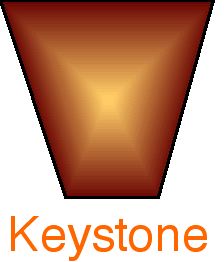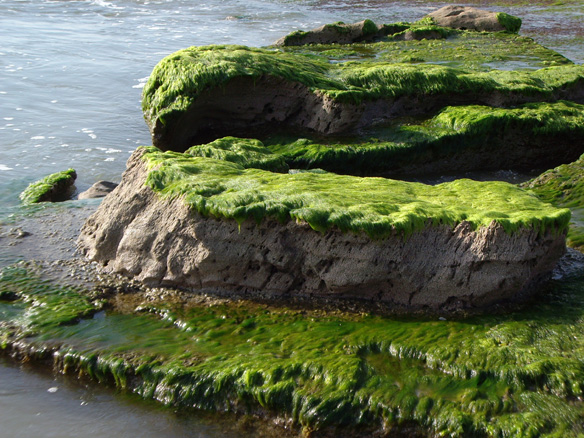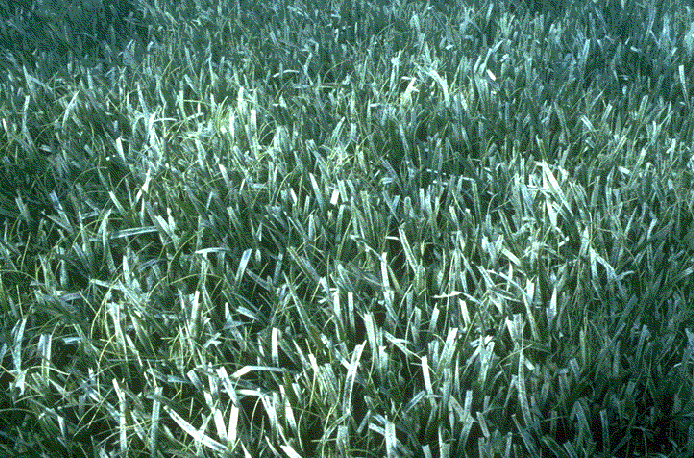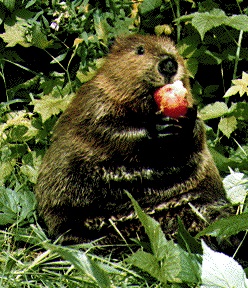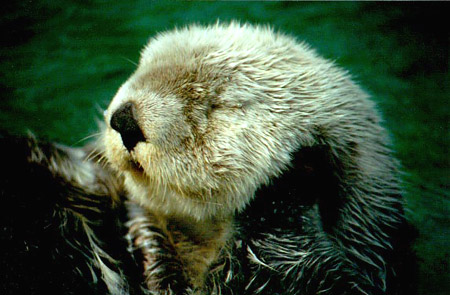 Interdependency Argument
Interdependency Argument Reefs | Kenya | Florida | United Kingdom | Everglades | North America | Pacific Ocean | photograph
In the arid, sand regions of Florida's interior there is an important resident for whom many other animals depend. Field reconnaissance has shown up to 250 other species depend on the gopher tortoise burrows. This burrowing tortoise is an indicator of sandhill communities originally dominated by long leaf pine and wiregrass vegetation, but has become accustomed to dry scrub and sand communities from central Florida, to Mississippi and South Carolina. Once islands in a warm sea, these sandhill regions are characterized by white sugar sand with sparse or drought tolerant and fire adapted vegetation.
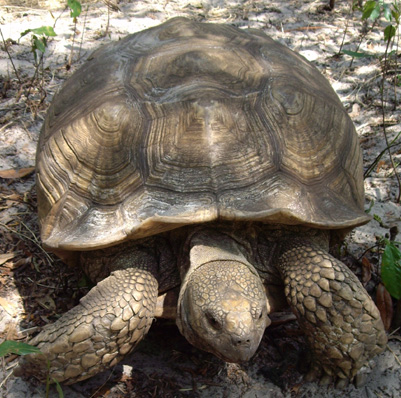
Florida's Gopher Tortoise, gopherus polyphemus
The tortoise above shares certain qualities with beavers, sea otters and the worm reefs pictured below, in that each animal functions as part of a far more complicated living and feeding relationship with respect to the habitats in which they reside.
Because so many other creatures depend on them, these animals are called keystone species. The importance of keystone species must not be underrated as their extirpation from a region cause the collapse of those species that depend on the keystone species for survival. This was most obvious with the local extinction of beavers during the fur trade industry, but was not well understood or documented in the literature until the sea otter of central California was studied. The decline in sea otter numbers due to fur traders along the coast, led to an increase in the sea urchin populations that began to feed on the structures called "holdfasts" that keep giant kelp attached to the sea floor. As tech kelp beds vanished the fisheries associated with these giant brown algae forests disappeared as well. Thus it was understood that the sea otter was a functionally important contributor -- or a keystone-- species in the coastal biocoenose, or ecosystem of the kelp bed forests.
Sabellaria vulgaris verrill, a reef building polychaete worm colony, Atlantic ocean south of Cape Canaveral Florida, 2008.
Built upon the underlying coquina rock that just up from below the sand here, sedentary polychaete worms Sabellaria vulgaris Verrill, (called the honeycomb worm in the U. K. ) builds tubes from sand and shell forming colonies that attract fish, birds and algae to this shoreline In Melbourne Beach, central Florida. Sabellaria vulgaris Verrill are indicators of the sub-littoral or lower tide zone along the sandy shore. The worms can cluster up to thirty or forty per square millimeter and attach sand or shell grains with mucous to form the remarkably wave-resistant tubes in which the animals live and feed.
As a keystone species the worms are peculiar to sandy beaches with high wave activity and an immobile substrate on which the worms may build their reefs. They appear to be confined to areas with an adequate supply of suspended sand grains from which the animals form their tubes, and include areas where an attachment may be established.
The larvae are strongly stimulated to settle by the presence of existing colonies or their dead remains. Sabellaria sp. is characterized by a variable recruitment and the cover in any one area may vary greatly over a number of years, although in the long term reefs tend mainly to be found on the same shores.
These reefs are rare in that they are found only on shores with strong to moderate wave action, in moderate water temperatures, where clay or sand integrates hard bottoms. Such places besides central Brevard County along Florida' Atlantic Ocean, include south and western Britain (Cumbria and Wales) on the Irish Sea, the Gulf of Valencia, in Spain, or California. They are characteristic of sub-tropical and tropical shores, such as Fiji, but extend to the temperate waters of the Solway firth in Scotland, Delaware Bay, and Cape Cod.
Studies reveal these reef builders are sensitive to disruption in sand, or sediment size.
![]() Sand Grain Size is discussed in:
Sand Grain Size is discussed in:
Sand Grain Size Distribution in Tubes of Sabellaria vulgaris Verrill
Colin P. Rees
Chesapeake Science, Vol. 17, No. 1 (Mar., 1976), pp. 59-61 (article consists of 3 pages)
Published by: Estuarine Research Federation
Sabellaria alveolata, in the U. K.
Author: Eklöf, Johan S.
Title: Anthropogenic Disturbances and Shifts in Tropical Seagrass Ecosystems
Department: Stockholm University, Faculty of Science, Department of Systems Ecology
URI: urn:nbn:se:su:diva-7285. Publication type: Doctoral thesis
Keywords: Aquaculture, feedback mechanisms, Kenya, management, overgrazing, regime shift, resilience, seagrass, seaweed farming, sea urchins, Tanzania, trophic cascades, Zanzibar, 2-08-2008;
Seagrasses constitute the basis for diverse and productive ecosystems worldwide.
In East Africa, they provide important ecosystem services (e.g. fisheries) but are potentially threatened by increasing resource use and lack of enforced management regulations. The major aim of this PhD thesis was to investigate effects of anthropogenic distur-bances, primarily seaweed farming and coastal fishery, in East African seagrass beds.
Seaweed farming, often depicted as a sustainable form of aquaculture, had short- and long-term effects on seagrass growth and abundance that cascaded up through the food web to the level of fishery catches.
The coastal fishery, a major subsistence activity in the region, can by removing urchin predators indirectly increase densities of the sea urchin Tripneustes gratilla, which has overgrazed seagrasses in several areas. A study using simulated grazing showed that high magnitude leaf removal – typical of grazing urchins – affected seagrasses more than low magnitude removal, typical of fish grazing.
Different responses in two co-occurring seagrass species furthermore indicate that high seagrass diversity in tropical seagrass beds could buffer overgrazing effects in the long run. Finally, a literature synthesis suggests that anthropogenic disturbances could drive shifts in seagrass ecosystems to an array of alternative regimes dominated by other or-ganisms (macroalgae, bivalves, burrowing shrimp, polychaetes, etc.).
The formation of novel feedback mechanisms makes these regimes resilient to disturbances like seagrass recovery and transplantation projects.
Overall, this suggests that resource use activities linked to seagrasses can have large-scale implications if the scale exceeds critical levels. This emphasizes the need for holistic and adaptive management at the seascape level, specifically involving improved techniques for seaweed farming and fisheries, protection of keystone species, and ecosystem-based management approaches.
J. Siry, Marshes of the Ocean Shore.
Sirenia Project on Trichechus manatus latirostris
Facts about the West Indian Manatee, subspecies in Florida and the Antillean subspecies.
Trichechus manatus latirostris is a subspecies of the West Indian manatee. Scientists have determined that animals of this subspecies face the additional threat of low genetic diversity, a trait that could make them more susceptible to diseases and more sensitive to climate changes. The marine mammal is an indicator of fresh, estuarine and salt water habitats in Georgia and Florida.
IUCN Red list of endangered, threatened and species with declining populations or fractured habitats.
Zostera marina beds on lower shore or infralittoral clean or muddy sand seagrass beds.
What's it like?
Grab samples taken during the survey revealed a network of grassy blades bound into the sand which were identified as the seagrass Zostera marina. Sea grass is an angiosperm (a flowering plant) much the same as ordinary grass only it has adapted to survive in the sea. There are 3 species of seagrass commonly found in the UK of which Z. marina is the deepest being typically found to depths of 10m. The depth where Zostera was found in our survey was slightly deeper than 10m possibly indicating that this were close to the seaward limit of a larger seagrass bed.
What lives on seagrass beds?
The presence of seagrass in the marine environment dramatically alters the types of organisms that live there and their numbers. The grass itself forms a dense network of interconnecting roots or rhizomes which help to stabilize the underlying sand and allow oxygen to penetrate deeper. The dense bed of grassy blades acts as a break water to the current slowing down the water and allowing suspended particles to be deposited onto the seafloor. This provides an ideal habitat for a variety of organisms which live in the sediment, feeding on the constant supply of food rich material by burrowing through the sand or extending feeding tentacles to catch food as it sinks. The sea potato (Echinocadium chordatum, a sea urchin) can be found burrowing through the sediments. Razor shells and other shellfish bury into the sand extending feeding tubes called siphons above the surface to suck in any food particles that drift by. A variety of worms can also be found either burrowing or extending feeding tentacles as a net to trap particles from the water.
The blades of grass rise above the sediment surface providing a larger area for organisms to colonize and feed on. They support a variety of algae which grows on them epiphytically. This algae supports a number of herbivorous grazing organisms such as marine snails which prevent the algae out-competing the seagrass for light and nutrients. Predatory marine snails are also found feeding on their herbivorous relatives and anemones might be seen attached to the grassy blades feeding on food particles in the water.
The bed as a whole provides a more sheltered environment for smaller more mobile animals living in the water column. In the south west of England seahorses (Hippocampus spp.) are often seen in association with seagrass clinging on with their tails for support in the current. The 15 spined stickleback (Spinachia spinachia) might be seen building a nest for its offspring while two spot gobies might be sheltering among the grass from potential predators. Juvenile bass may also be seen using the region as a nursery ground with other fish where they can feed in relative safety from predation in comparison to the open environment.
Florida Bay and glades restoration
The task of this team has been to identify a representative list of native species of animals, which can serve as indicators of the health of regional ecosystems, and which are judged to be important for the contributions that each makes to the character, diversity and personal enjoyment of the natural areas of south Florida. For each species selected, the team has recommended a long-term recovery goal for the population in south Florida, and indices which can be used to measure whether the restoration programs are producing the desired changes or conditions in these populations.
Species selected by the team were ones which met all or most of the following criteria: (1) they must be species which we would expect to be responsive to regional, ecosystem restoration programs; (2) we must understand enough of the past and current status (including inter annual variability), the biology, and the regional ecology, to be able to interpret the responses of each to restoration programs; (3) they must be species which can be reasonably well monitored over large spatial and temporal scales; and (4) they should be species which are considered by a relatively large part of the human population in Florida to be charismatic or, by some other standard, to have a high profile among human value systems.
The team also placed value in selecting a diverse enough array of species such that, (1) each of the nine ecological subregions in south Florida (Science Sub-Group 1993) would contain one or more of the selected species, (2) the list would include both wetland and upland species, and (3) the list would include representation from the major taxonomic groups (mammals, birds, etc.). . . .
The list of animals recommended by the team to serve as indices for measuring the success of ecosystem restoration programs in south Florida contains the following endangered, threatened, keystone and indicator species: Florida Panther, West Indian Manatee, Brown Pelican, Wood Stork, Bald Eagle, Osprey, Snail Kite, White-crowned Pigeon, Red-cockaded Woodpecker, Cape Sable Seaside Sparrow, American Alligator, American Crocodile, Green Turtle, Loggerhead Turtle, Tree Snail (Liguus). A separate account for each of these species is attached.
RECOVERY OF REGIONALLY HEALTHY POPULATIONS OF ENDANGERED, THREATENED, KEYSTONE AND INDICATOR SPECIES OF ANIMALS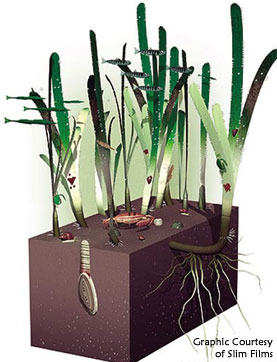
Zostera marina is a marine flowering plant that grows in soft-bottom (sand/silt) habitats in nearshore environments throughout the temperate regions of the Northern Hemisphere.
Spreading by creeping rhizomes and seed set, these submerged plants can form disconnected patches or large meadows, depending on environmental conditions, which in turn provide valuable ecological services.
Eelgrass prairies provide critical food, shelter and migratory habitat for hundreds of species of fish, birds and invertebrates. Species commonly associated with Z. marina meadows in San Juan County --Puget Sound-- include out-migrating juvenile salmon, Pacific herring, Dungeness crab and Great Blue Herons.
Zostera marina (eelgrass) resources
In the intertidal zones, the vegetation is generally dominated by eelgrasses Zostera spp, which are generally replaced by Ruppia spp in the calmer, more enclosed, and warmer waters of saline ponds. These two herbaceous plants are perennials and form important spawning beds and feeding zones for coastal fish, and attract many herbivorous waterfowl.
Dominican Republic Seagrass study
Castor canadensis, the North American beaver, was nearly hunted to extinction, over ever wider areas because the possessed such lustrous fur that was a source of pelts and even mens' hats.
Like many wildlife species, beavers self-regulate by starting to decrease their rate of reproduction when occupancy reaches a certain level, that population level may be related to the concept of "carrying capacity." In vast areas without trapping, beaver populations may peak, and then slowly drift down to a sustainable level. By the early 1900s, beavers were almost extirpated from North America due to trapping and draining of lands for agriculture.
To drain, reclaim and reclamation means?
Estimates of the current population are as low as five percent of those present prior to European settlement. That means --for example-- that the water table, or level of water in the strams and underground, was much higher when there were larger populations of beaver from what the level of water is today. With swamps and lakes created by beaver's impounding water upstream, there was greater evaporation of water in vast portions of North America that are subject to summer heat waves. As a consequence, the potential for greater rainfall in preindustrial and pre-agrarian America was greater than it is today, despite the recovery of extensive forests in the northeast.
Predation
Known predators
* wolves (Canis lupus)
* wolverines (Gulo gulo)
* lynx (Lynx canadensis)
* northern river otters (Lontra canadensis)
* humans (Homo sapiens)
* black bears and brown bears (Ursus)
* fishers (Martes pennanti)
Young beavers are very vulnerable, and are threatened by bears, wolves, wolverines, lynx, fishers and otters. An adult beaver's size is a deterrent to most predators, and though natural predators pose a very real danger to kits, man has proven to be, by far, the most dangerous predator to beavers. Killing beavers for their pelts, disrupting them through a change in habitat, and slowly poisoning them through pollution, which is known to infect wounds, all have lead to the threat which man poses on beavers. (Toronto Zoo, 2000)
Beavers, by obstructing water flow and impounding water, regulate the flow downstream but also allow vegetation to thrive that would not otherwise colonize riversides. The vegetation attracts wildlife such as moose who come to feed on certain submerged aquatic vegetation. Insects and birds are attracted to the marshes and reeds that grow as teh water levels rise, and a these species attract an enormous array of predators that would go elsewhere on the streams or tributaries. American Indians called the beaver the "sacred center" of the land because this species creates rich habitats for other mammals, fish, turtles, frogs, birds and ducks.
What do beavers eat?
Not fish, but trees such as aspen, willow, birch and even maple as well as various woody shrubs. Willow and aspen seem to be their favorites. They also eat roots of tuberous aquatic plants, especially pond lilies which they utilize more during summer months. In this sense they thin out the vegetation, if their populations are not kept in check by wolves, bears or cats. Studies in New Brunswick reveal that beavers affect on habitat quality (food availability) on the foraging behaviour has been tested. The results of that study suggested that with increasing distance from the pond, beavers in high-quality habitats selected fewer, but larger, trees and are more species selective. This selectivity was diminished in habitats of lower quality.
Frogs and insects are just some of the species that depend on the activity of beavers.
Frogs for example thrive due to the beaver's presence along streams. Surveys indicated that beaver create breeding habitat for the boreal chorus frog (Pseudacris maculata), wood frog (Rana syluatica) and western toad (Bufo boreas). No calling males of any species were recorded on unobstructed streams. Wood frog, the most abundant species, exhibited high rates of juvenile recruitment on beaver ponds. Pitfall traps captured more wood frogs on beaver ponds versus unobstructed streams, and most individuals (84%) were young-of-year. Abundance of young-of-year was strongly correlated with percent landscape occupied by beaver ponds indicating that anurans captured along streams originated in beaver ponds.
Ecosystem Roles
Beavers maintain wetlands that can slow the flow of floodwaters. They prevent erosion, and they raise the water table, which acts as a purifying system for the water. This happens because silt occurs upstream from dams, and toxins are then broken down. As ponds grow from water backed up by the damn, pond weeds and lilies take over. After beavers leave their homes, the dams decay, and meadows appears. (Frazier, 1996)
Acts as a keystone species, that is a species whose presence or absence strongly affects populations of other species in that area such that the extirpation of the keystone species in an area will result in the ultimate extirpation of many more species in that area (Example: sea otter).
Enhydra lutris lutris, and Enhydra lutris nereis, the Pacific sea otter preys on urchins, shell fish, snails such as the gastronomic deleicacy, abalone, and crabs. The mammal keeps the size of its prey population of sea urchins at a reasonable level. That level of sea urchin population is just below what is sufficient because too many sea urchins eat away at the base of brown algea, or kelp forests and countless fish depend on such forests to feed, nurse their young or hide from deep ocean predators. Sea otters must eat 25% of their body weight each day in order to stay alive. That means a 18 kg sea otter must eat 4.5 kg of food each day.
The IUCN says:
"In the modern world sea otters are oceanic emissaries, and they function as a keystone species in the nearshore marine system. Current studies have shown sea otters serve as important sentinels of changes in the health of their ecosystem."
The southern sea otter was thought to be extinct. Then, in 1938, a raft of about 300 sea otters was discovered off the coast of Big Sur, California. This group has spread along the 322 km of California coastline, but its population is still small—only about 2,300.
Sea otters, Enhydra lutris, rest in kelp forests, in groups called rafts. Often they will drape the kelp over their bodies like a blanket to keep from drifting away. They are found in coastal waters in the central and north Pacific Ocean. Past distribution of the sea otter included Hokkaido Island of Japan north through the Kuril Islands and eastern coast of Kamchatka, east through the Commander Islands and Aleutian archipelago, the southern coast of Alaska, and the west coast of North America to Baja, Mexico. Sea ice limits their northern range to below 57°N latitude, and the distribution of kelp forests limits the southern range to about 22°N latitude.
The southern sea otter (Enhydra lutris nereis) population has grown at a notably lower average annual rate than other recovering sea otter populations and has been declining in abundance recently. Increased mortality, specifically due to infectious disease, is a likely cause for this depressed rate of population growth. Toxoplasmosis is currently the most common cause of death in California otters, and while exposure to this pathogen may be highly prevalent in wild animal populations, exposure is generally not associated with severe clinical disease in healthy, immunocompetent animals. Wastewater runoff carrying pathogens and contaminants into the coastal environment, and the bioaccumulation of these pathogens in shellfish prey, may be contributing to the occurrence of emerging diseases that are hindering the recovery of the southern sea otter population. Sea otters are a good biological parameter with which to measure the impacts of anthropogenic input into marine systems because both otters and their main prey live in geographically localized areas along the California coastline, which has been subject to extensive modification by human activity.
Christine Kreuder, "Southern sea otters (Enhydra lutris nereis) and emergent disease in the near-shore marine ecosystem: Assessment of spatial trends in cause-specific mortality from 1998-2001 and evaluation of an aerial survey method for surveillance of trends in mortality" (November 29, 2004). Coastal Environmental Quality Initiative. Paper 005.
Amphipods are invertebrates that are important food sources for fisheries:
Distribution: Ampelisca abdita are found in the shallow marine waters from Maine to Louisiana (Mills, 1967) and along the entire U.S. Pacific coast (Grosse et al. 1986). A. abdita are typically observed in the fine sands of estuaries (Caracciolo and Steimle 1983, Franz and Harris 1988), and are generally limited to approximately 27 meters in depth (Mills 1967).
Feeding. These amphipods feed with their ventral surfaces facing upwards from the tops of their tubes. This positioning allows them to detect movement around the tube, which initiates feeding activity. Suspended particles (including algae, sediment grains, and organic detritus; Redmond et al. 1994) are accumulated at the midline portion of the body and are then brought to the mouth. A. abdita can also set up a current by using its pleopods and second antennae to direct sand grains and detrital material to its midline (Mills 1967).
Ampelisca distribution map - 1995
Fishery. Though there is no commercial fishery for amphipods, A. abdita and other gammarids are an invaluable food source for many economically important fish and invertebrate species.
Sea Stars, Pisaster ochraceus.
Science, 26 March 1999:
Vol. 283. no. 5410, pp. 2095 - 2097
DOI: 10.1126/science.283.5410.2095
REPORTS
Regulation of Keystone Predation by Small Changes in Ocean Temperature
Eric Sanford
Key species interactions that are sensitive to temperature may act as leverage points through which small changes in climate could generate large changes in natural communities. Field and laboratory experiments showed that a slight decrease in water temperature dramatically reduced the effects of a keystone predator, the sea star Pisaster ochraceus, on its principal prey. Ongoing changes in patterns of cold water upwelling, associated with El Niño events and longer term geophysical changes, may thus have far-reaching impacts on the composition and diversity of these rocky intertidal communities.
Department of Zoology, Oregon State University, Corvallis, OR 97331-2914, USA. E-mail: sanforde@bcc.orst.edu.
Lessons
If you lose a keystone species the archway of ecological integrity can collapse. Thus it is a species that plays an important ecological role in determining theoverall structure and dynamic relationships within a biotic community. A keystone species presence is essential to the integrity and stability of a particular ecosystem.
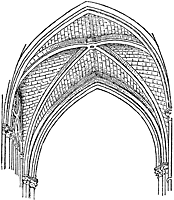 A vault is the intersection of two two arches arranged perpendicular to one another and are stronger to the union of the two arches.
A vault is the intersection of two two arches arranged perpendicular to one another and are stronger to the union of the two arches.
The vault is a better representation of the role that certain keystone species and keystone biotic communities play in the larger architecture of estuaries, forests, coral coasts, tundra, or extensive grasslands.
That is because if we make the analogy of the vault to a complex biological community, the strength of the intersecting arches and their keystones can hold up, support, or sustain a greater edifice. When we think of a forest, estuary or coral reef we should envision an edifice --built by contributing species in nature-- to the functional integrity of the whole that we may harvest as timber, fisheries, or security over the long-term.
For example, the keystone species in an estuary are numerous, sea grasses, oyster reefs, blue crabs. For example, Like coral reefs, Hudson River oyster reefs provided habitat for commercially and recreationally important fish, such as striped bass and flounder, and for other marine organisms. Oysters also clean their ecosystem, acting as a natural water filter. As they feed they remove suspended sediments and algae, improving water clarity and enhancing conditions for underwater grasses to grow.
The San Francisco Bay study researchers argued that "Using the species selection criteria, the focus teams screened nearly 400 species, ultimately selecting 121 key species to represent the baylands communities of fish and wildlife."
These are just some of the many species they argued are key to estuarine productivity and thus recovery:
- Chinook salmon, Oncorhynchus tshawytscha
- Steelhead trout, Oncorhynchus mykiss
- White sturgeon, Acipenser transmontanus
- Striped bass, Morone saxatilis
- Sacramento splittail, Pogonichthys macrolepidotus
- Pacific herring, Clupea pallasi
- Northern anchovy, Engraulis mordax
- Arrow goby, Clevelandia ios
- Bay gob,y Lepidogobius lepidus
- Delta smelt, Hypomesus transpacificus
- Jacksmelt, Atherinopsis californiensis
- Topsmelt Atherinop, Atherinops affinis.
Many of them are a habitat Indicator: that is a species is indicative of a key habitat. The presence of the species defines the habitat.
White sturgeon (Acipenser transmontanus), mud crabs (Hemegrapsus oregonensis), red knots and ducks are a Community Indicator: that is, species indicative of a community, guild, or assemblage of species. A community indicator can represent other species because of similar habitat requirements or behavior.
The important thing for us to understand is the general concept of keystone species, the need to protect them, and the fact that there are many keystone species that have yet to be identified by scientists.
Coastal Zone Management essay | Sample long essay
Date: 19 January 2008

